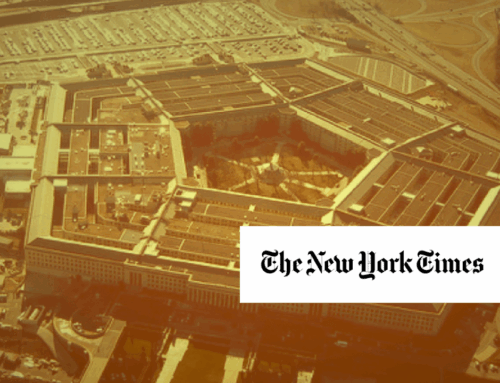It’s Spring, finally. The promise of cherry blossoms fills the air in Washington. It’s also that time of year in the nation’s capital when a young General’s or Admiral’s fancies turn to thoughts of…well, not love…but unfunded priorities.
First, a bit of (very) recent history:
The President’s Budget Request for the Pentagon was $535 billion with an additional ~$58 billion in Overseas Contingency Operations (OCO) funds for the Departments of Defense and State. That’s about $35 billion more in base budget than allowed under the Budget Control Act (BCA) caps. And, as we’ve noted many times before, much of the OCO funding is an off-budget slush fund to end run the BCA caps.
Congress turned around and added a roughly billion dollar cherry on top of the aggregate amount (~$594 billion) in the request, but they put the entire budget cap busting spending in the OCO slush fund ($499 billion base, $96 billion slush fund for both State and DoD).
Leaving aside the utter abdication of fiscal responsibility on the parts of both the President and Congress, the military services were not sated. On March 27th, the military services and the National Guard Bureau sent their “unfunded priorities lists” (UPLs) to the committees overseeing Defense spending. This is for extra cash – on top of the more than $590 billion that was in both the President and Congressional budgets. This is the equivalent of an Amazon gift list with more than $21 billion worth of spending “priorities” that would buy with the extra cash.
If fully funded, this wish list would represent the tenth largest agency in the budget request. That is more than was requested for the individual discretionary budgets of NASA, DOJ, DOT, Labor, DOI, Treasury, Commerce, EPA, and the U.S. Army Corps of Engineers.
Defense Secretary Carter’s cover letter forwarding the package noted ominously: “I do not endorse any of these additional priorities unless enacted funding exceeds the amount requested in the President’s Budget (PB) for 2016…Any extra program inserted into our budget submission will come at the expense of other programs we deemed more important, with ripple effects across the rest of the budget.”
So in other words, don’t go mixing and matching. If you want us to buy these additional baubles, it’s going to cost you – well, cost taxpayers. Former Defense Secretary Gates pretty much eradicated the UPLs, but now they seem to be back with a vengeance.
Note: A large portion, but not all, of the money in these requests is devoted to procurement, which also sometimes falls under the category “modernization.” Here are some “highlights” of the requests.
ARMY UNFUNDED REQUEST
The Army’s total unfunded request is $7.6 billion, with $2.1 of that being “modernization” and, curiously, another $2.1 billion in “installation readiness.” Some contractors or other entities who would win big in the Army’s request:
|
Army Program
|
Cost
($ in millions) |
Contractor
|
|
MQ-1C Gray Eagle
|
$48.0
|
General Atomics
|
|
M88A2 Med. Recovery Vehicles
|
$72.0
|
BAE Systems
|
|
Javelin missiles
|
$91.0
|
Raytheon, Lockheed Martin
|
|
PAC-3 Missile Segment Enhance.
|
$200.0
|
Lockheed Martin
|
NAVY UNFUNDED REQUEST
The Navy’s total unfunded request is $2.7 billion with the vast majority going to two aircraft programs, the Super Hornet and the Navy’s variant of the F-35.
|
Navy Program
|
Cost
($ in millions) |
Contractor
|
|
F/A-18F Super Hornet (12)
|
$1,150.0
|
Boeing
|
|
F-35C (8)
|
$1,040.0
|
Lockheed Martin
|
|
C-40A (2)
|
$187.0
|
Boeing
|
|
MQ-4c Triton
|
$65.0
|
Northrop Grumman
|
MARINE CORPS UNFUNDED REQUEST
The Marine Corps’ total unfunded request is $2.1 billion with more than half actually going to items that must be funded within the Navy’s budget. Almost $1.4 billion is for aircraft, with the vast majority of that for an additional 6 of the Marine variant of the F-35.
|
Marine Corps Program
|
Cost
($ in millions) |
Contractor
|
|
F-35B (6)
|
$1,050.0
|
Lockheed Martin
|
|
KC-130J (2)
|
$180.0
|
Lockheed Martin
|
|
Javelin Missiles
|
$77.5
|
Raytheon, Lockheed Martin
|
|
TOW Missiles
|
$145.5
|
Raytheon
|
|
Counter Radio-Controlled Improvised Explosive Device
|
$75.0
|
Northrop Grumman
(doing development work) |
AIR FORCE UNFUNDED REQUEST
Well, the Air Force request is a little bit different. It asks for $5.5 billion but then in the so-called “description” part of the table, they spend just 127 words – or about $43 million a word – explaining how they will spend the money. Words like “ensure future capabilities” and “preparedness for day-to-day, contingency, and combat operations” and “various aircraft.” So we can’t tell you what contractors will benefit from the Air Force request.
|
Air Force Program
|
Cost
($ in millions) |
Contractor
|
|
Readiness
|
$868.5
|
?
|
|
Modernization
|
$2,425.6
|
?
|
|
Force Structure
|
$1,300.1
|
?
|
|
Installation Support
|
$873.6
|
?
|
NATIONAL GUARD BUREAU UNFUNDED REQUEST
The National Guard Bureau (NGB) Request totals $3.3 billion and gives greater detail than the Air Force request, at least in most cases. We can tell you what programs are receiving more funding, but not always how much money they are receiving within large categories. And then there is the line item “turbulence” described as “Un-programmed requirements due to changing force structure; rebalancing ~8K force structure.” Moving people around will set the taxpayers back $178.9 million.
Among the contractor highlights in the NGB request:
|
NGB Program
|
Cost
($ in millions) |
Contractor
|
|
Large Aircraft Infrared Countermeasures
|
$375.0
|
Northrop Grumman, Elbit, ITT, BAE Systems
|
|
Advanced Simulators
|
$96.5
|
?
|
|
Battlefield Airman Combat Equipment
|
$91.6
|
?
|
|
F-15/F-16 Sensor upgrades
|
$700.7
|
Various
|
We’ll keep digging, but meanwhile you can look at the documents themselves here:










